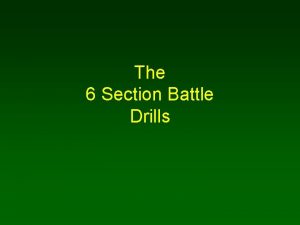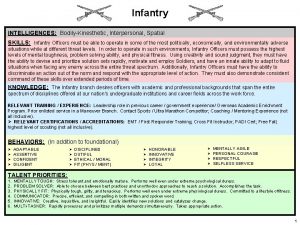Weaponry Infantry The fighters the ones on the




- Slides: 4

Weaponry

Infantry The fighters, the ones on the frontlines. They used the smoothbore, muzzleloading flintlock musket. This musket shot a smooth lead ball about 3/4 of an inch in diameter with an effective range of less than 50 yards. The musket used in the French and Indian War was called a Long Land Pattern and had a 46 inch long barrel. Long Land Pattern

Cavalry Accompany many of the generals, lieutenants, and commanders The cavalry as most people know consists of riding a horse. The horse itself can definitely be considered a weapon because it gives the person riding it a definite transportation advantage along with a height advantage. Members of the cavalry unit would often use as a primary weapon a straight, single edged, saber; very similar to the current day machete, except skinnier. Another weapon members of the cavalry utilized was the carbine musket. Much like pistols, these were shorter, more easily carried muskets better for shooting while moving on horseback Carbine Musket

Artillery The “boom” section. The weapons in this section during our era include: horse drawn cannons, siege guns, howitzers and mortars. Horse drawn cannons could take out a group of infantry with one shot. The ammo for this weapon would vary according to the distance of the desired shot. For long range, a smooth lead ball weighing from 3 to 10 pounds would be loaded. For medium range, a group of small cannon balls linked together called a grapeshot would be loaded. For short range, they would load a canister into the weapon, basically making it a huge shotgun shell often filled with small cannon balls, bullets, rusty nails, or whatever they could find that could do damage. Siege guns were huge and could throw cannon balls weighing up to 100 pounds over a mile. Howitzers and mortals would fire projectiles over enemy barriers to destroy infantrymen. Howitzer







